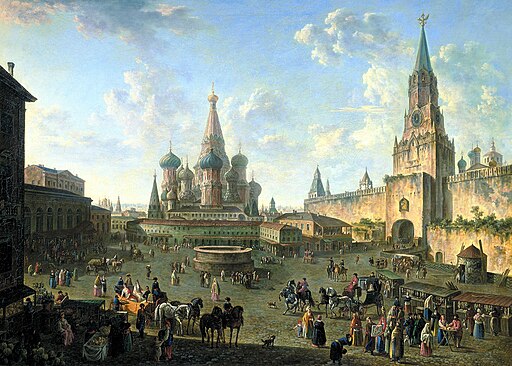
“Roman Capriccio: The Pantheon and Other Monuments” by Giovanni Paolo Panini depicts an array of famous Roman monuments in a rural setting.
Panini was a famed painter of capriccios or architectural fantasies. This composition has combined several ancient buildings and monuments from Roman into one convenient location without regard to actual topography.
From left to right, he included the Temple of Hadrian, the Pantheon, the Temple of Vesta, the Maison Carrée, and the Theater of Marcellus, and the Obelisk of Thutmose III.
In the center is the Equestrian Statue of Marcus Aurelius, around which are shown ancient Roman peasants living their ideal lives.
These capriccio paintings were created for wealthy European youths who undertook the Grand Tour, about two to three hundred years ago. They could afford to bring back beautiful paintings as souvenirs and as memories of their travels.
Thus, sketches and paintings of landmarks such as those in the Capriccio were in high demand. They were compositions that could be shown-off back home in high society to demonstrate the sites they visited. Geographical accuracy was not as important as the ideal image of famous monuments and sites.
So Panini and his contemporary painters were free to rearrange scenery in paintings in imaginative ways. This creative reorganization led to a better comprehension of the ideal, rather than current, conditions of the monuments. These paintings idealized the civilizations that created them.
In this painting, Panini has attempted to be faithful to the original architectural reconstructions. He edited out modern additions to the original ancient buildings, such as the walled-in sections in the arches of the Theater of Marcellus.
These images also had a pronounced influence on the architecture of neo-classical buildings in large cities and the capitals of Europe and the Americas.
Capriccio Art
In painting, a capriccio means an architectural fantasy, placing together buildings, archaeological ruins, and other structural elements in fictional combinations.
These paintings also included figures to demonstrate scale. Capriccio paintings fall under the more general term of landscape painting.
This style of painting was introduced in the Renaissance and continued into the Baroque.
One of the best-known proponents of capriccio was the artist Giovanni Paolo Pannini. This style was extended in the 1740s by Canaletto in his vedute.
Many other painters have also experimented with the method, including J. M. W. Turner, with his Carthage paintings.
Giovanni Paolo Panini
Giovanni Paolo Panini, or Pannini (1691 – 1765), was a painter and architect who worked in Rome and is primarily known of his vedutisti (“view painters”).
Among his most famous works is his view of the interior of the Pantheon, and his vedute—paintings of picture galleries containing views of Rome. Most of his works, especially those of ruins, have a fanciful and unreal embellishment characteristic of imagined architectural themes.
Panini’s style influenced other vedutisti, such as Antonio Joli, Canaletto, and Bernardo Bellotto. They all sought to meet the need of visitors for painted “postcards” depicting the Italian monuments and views.
Some British landscape painters, such as Marlow, Skelton, and Wright of Derby, also imitated his architectural depictions.
Roman Capriccio: The Pantheon and Other Monuments
- Title: Roman Capriccio: The Pantheon and Other Monuments
- Artist: Giovanni Paolo Panini
- Year: 1735
- Medium: Oil on canvas
- Dimensions: Height: 39 in (99 cm); Width: 53.5 in (135.8 cm)
- Museum: Indianapolis Museum of Art
Giovanni Paolo Panini
- Name: Giovanni Paolo Panini
- Born: 1691, Piacenza, Duchy of Parma, Holy Roman Empire
- Died: 1765 (aged 74), Rome, Papal States (now Italy)
- Nationality: Italian
- Notable Works
- Interior of the Pantheon, Rome
- Picture Gallery with Views of Modern Rome
- Gallery of Ancient Roman Art
- Roman Capriccio: The Pantheon and Other Monuments
Giovanni Paolo Panini: A collection of 134 paintings
~~~
“Rome is the city of echoes, the city of illusions, and the city of yearning.”
– Giotto di Bondone
~~~
Photo Credit: 1) Giovanni Paolo Panini [Public domain] 2) Nono vlf [CC BY-SA 4.0 CreativeCommons
Popular this Week








 Sponsor your Favorite Page
Sponsor your Favorite Page SEARCH Search for: Search Follow UsJoin – The JOM Membership Program
Sponsor a Masterpiece with YOUR NAME CHOICE for $5
Share this:
- Tweet
